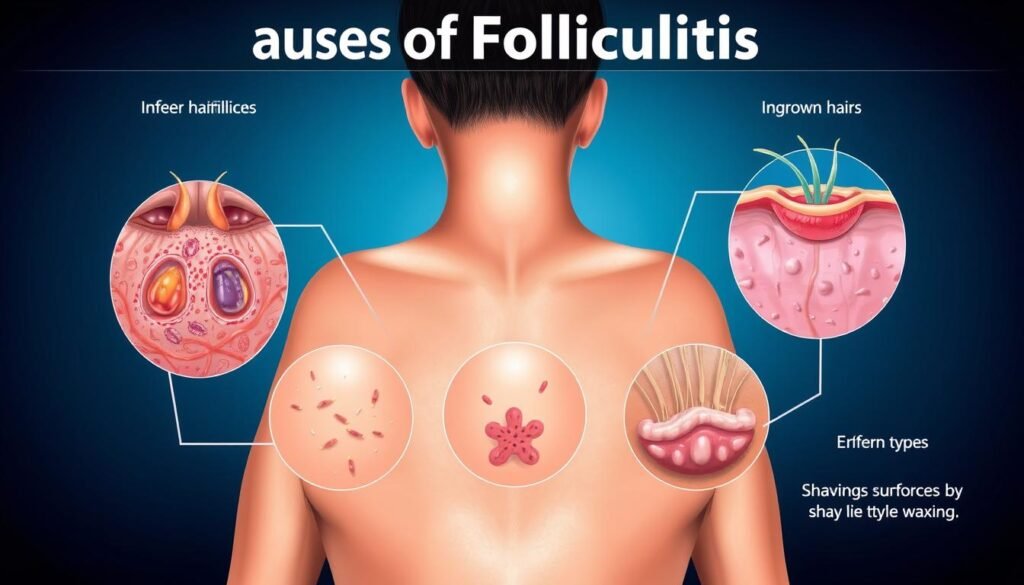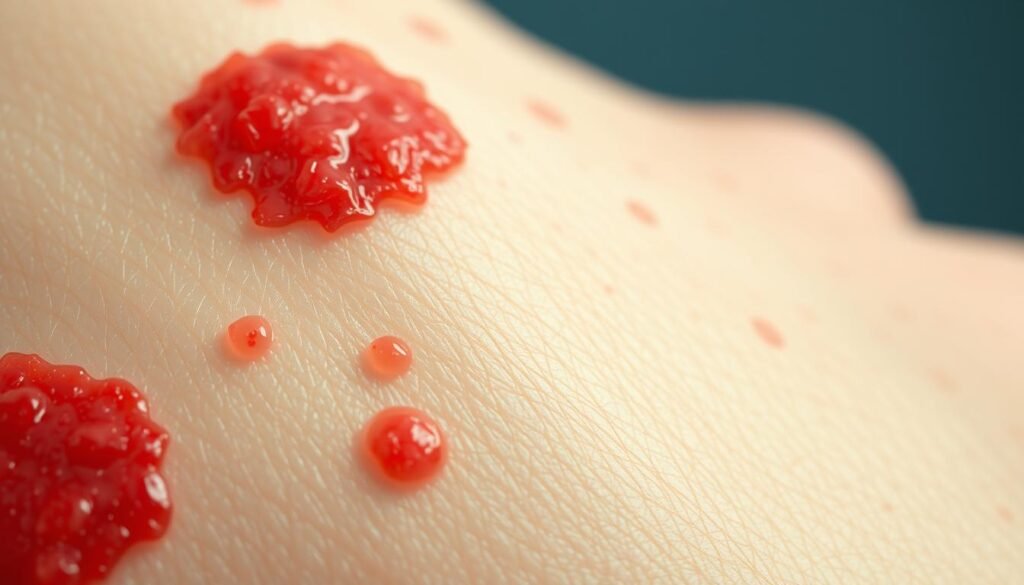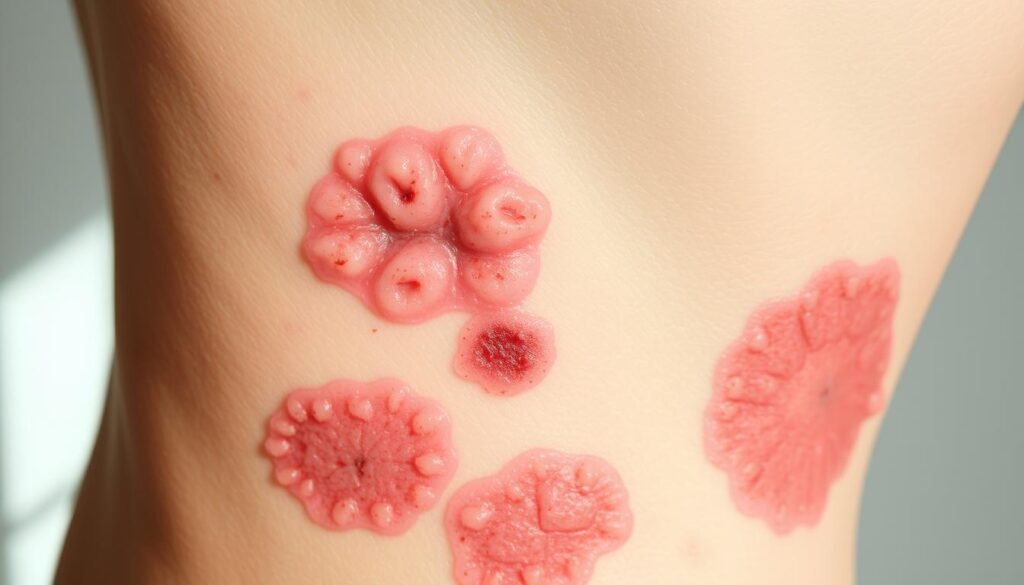Did you know more than half the people will get folliculitis during their life? This skin problem causes hair follicles to swell. It often goes unnoticed but can lead to scars and other lasting issues. Knowing about this condition is key, especially for those with chronic folliculitis. It can really affect skin health.
We’ll look at the different types of folliculitis, its signs, causes, and why quick treatment matters. Understanding folliculitis and how it can scar the skin helps. With this knowledge, you can better care for your skin.
Key Takeaways
- Folliculitis affects over half of the population at some stage.
- Chronic folliculitis can lead to significant skin issues over time.
- Recognizing early symptoms is crucial for effective management.
- Types of folliculitis include bacterial and fungal variants.
- Scarring and other long-term effects can be minimized with timely treatment.
Understanding Folliculitis
Folliculitis is a skin condition that involves inflammation of the hair follicles. It often results in red bumps or pus-filled bumps. These can appear anywhere on the body. They affect how the skin looks and its health.
It’s usually caused by bacteria or fungi. Shaving or wearing tight clothes can also lead to it. Knowing how to treat and prevent it is crucial for keeping skin healthy.
Infected hair follicles can upset the skin’s natural balance. This might make other skin problems worse. It’s important to take care of these issues early.
For more details on symptoms, causes, and how to treat folliculitis, check out this helpful article. It can help you make smart decisions for your skin’s care.
Types of Folliculitis
It’s crucial to know the different types of folliculitis for proper treatment and prevention. We have bacterial and fungal folliculitis. Each type has its own causes, signs, and ways to manage it. Understanding these can lead people to get the right help and change their habits if needed.
Bacterial Folliculitis
Bacterial folliculitis is often linked with the Staphylococcus aureus bacteria on our skin. It might pop up after shaving, wearing tight clothes, or using sports gear. Look out for red spots, itching, and soreness. Keeping clean and watching for skin changes can lower infection chances.
Fungal Folliculitis
Fungal folliculitis comes from too much fungi in warm, damp spots on the body. It’s common in the armpits and groin. It causes itchy, sore bumps just like bacterial types. Staying dry and taking care of your skin are good ways to avoid it. Biotin is important for your skin’s health too. Eating right or taking supplements can boost biotin levels for better skin, hair, and nails as health experts say.
| Type of Folliculitis | Causes | Common Symptoms | Prevention |
|---|---|---|---|
| Bacterial Folliculitis | Staphylococcus aureus, friction, irritation | Red bumps, itching, discomfort | Good hygiene, avoid tight clothing |
| Fungal Folliculitis | Fungal overgrowth, moist environments | Itchy, inflamed bumps | Keep skin dry, proper skin care |
Symptoms of Folliculitis
Folliculitis causes several symptoms of different strengths. Spotting these signs early can help manage them better. This avoids worse issues like folliculitis scars. It’s key to know these symptoms to tackle the condition well.
Common Symptoms to Watch For
At first, folliculitis symptoms may be mild but can get worse. Look out for:
- Itching in spots, growing more annoying over time.
- Redness near hair, showing inflammation.
- Pus-filled blisters, especially in bad cases.
- Crusting or scabbing as healing begins, sometimes leaving marks.
When to Seek Medical Attention
It’s important to know when these signs of folliculitis mean it’s time to see a doctor. Do so if:
- You’ve had symptoms for some days with no betterment.
- You have a fever with the symptoms, suggesting an infection.
- The redness and swelling get worse, showing a serious reaction.
- You notice new issues, like more pain or big, sore bumps.
Catching these signals early lets you handle the problem and cut down on the chance of lasting folliculitis scars.
The Causes of Folliculitis
Folliculitis appears due to different reasons that irritate and inflame the skin. The main causes are bacterial or fungal infections. These germs grow well in warm, damp places, making people more prone to getting it.
Too much sweating can worsen the situation. It creates a perfect place for bacteria to grow. Wearing tight clothes can cause friction. This friction makes hair follicles irritated, harming the skin’s protective layer and making infections more likely.
It’s also important to think about the environment. High humidity and being very close to others can raise your chances of getting folliculitis. Knowing why folliculitis happens helps people choose better skincare and prevent it.

Scarring and Other Long-Term Effects of Folliculitis
Folliculitis can leave long-term marks like scarring. It’s important to know how this scarring happens. It can show its effects on your skin’s health. The issue arises from ongoing inflammation and irritation. This leads to poor tissue repair.
How Scarring Occurs
Repeated folliculitis can harm your hair follicles. This results in scarring. The body tries to heal by making collagen. But too much inflammation makes too much collagen. This leads to scars that are raised or a different color. These scars show up as patches on the skin. They can last long after the inflammation has gone.
Impact on Skin Health
The effects of folliculitis are more than just visual. The scarring can change your skin’s texture and tone. This might lower your self-esteem and confidence. People dealing with this often feel it both emotionally and physically. Taking good care of your skin is key. It helps manage scars and supports overall skin health.
| Aspect | Effect of Folliculitis |
|---|---|
| Inflammation | Causes damage to hair follicles |
| Tissue Repair | Can lead to scarring if excessive |
| Skin Texture | May become uneven or bumpy |
| Skin Tone | Can lead to hyperpigmentation or discoloration |
| Emotional Impact | May affect self-esteem and confidence |
Chronic Folliculitis Explained
Chronic folliculitis is a lasting problem for many. It leads to repeated episodes that damage skin and cause stress. Knowing what causes it helps in dealing with it better.
Recurring Folliculitis Challenges
Having chronic folliculitis is tough. It often comes back, causing problems like:
- Increased skin irritation: The skin may become more sensitive with frequent episodes.
- Scarring risk: Ongoing inflammation can leave scars.
- Emotional impact: It’s stressful to deal with skin issues that others can see.
Keeping skin healthy is key when outbreaks happen often. For tips on managing this condition, check reliable sources.
Management Strategies
Dealing with chronic folliculitis needs several approaches. Effective methods include:
- Avoiding irritants: Stay away from things that cause flare-ups.
- Prescribed treatments: Treatments from doctors can help a lot.
- Good hygiene practices: Washing and moisturizing regularly helps prevent infections.
These strategies can make life better for those with chronic folliculitis. Understanding your skin lets you find the best ways to care for it.

Recognizing Folliculitis Scars
Folliculitis scars look different on everyone, making it important to know them well. Knowing your scars well helps catch issues early. This makes treating them easier. Two main kinds of scars, atrophic and hypertrophic, usually form.
Atrophic scars are kind of sunk into the skin because of tissue loss. This loss comes from skin getting inflamed. On the other side, hypertrophic scars stick out. They happen when too much tissue grows as the skin heals. Knowing the difference is key to understanding your skin.
Keep an eye on these scars, especially if they start to change. Being alert lets you find the right treatment early. This reduces the stress and upset that folliculitis scars can cause.
Permanent Skin Damage from Folliculitis
Folliculitis can lead to permanent skin damage, affecting one’s skin health deeply. Keloid scarring and hyperpigmentation are major effects. Knowing about these can help explore effective management methods.
Keloid Scarring
Keloid scars form when the body makes too much collagen during healing, creating raised scars. These scars can grow larger than the original injury, especially after folliculitis. If you’re prone to keloids, knowing your risk is crucial. Keloids are not just a physical issue; they can also affect you psychologically. To prevent them, treat folliculitis quickly and avoid skin injuries.
Hyperpigmentation Concerns
Hyperpigmentation can occur after folliculitis inflammation. It causes skin darkening in certain areas, which can be upsetting. This damage might take a long time to improve. For treatment, there are creams and laser options. Keeping up with a good skincare routine is vital to reduce hyperpigmentation chances.

| Type of Permanent Damage | Description | Management Strategies |
|---|---|---|
| Keloid Scarring | Raised, thick scars from excessive collagen production | Avoid skin trauma, early treatment of folliculitis |
| Hyperpigmentation | Darkened patches due to skin inflammation | Topical lightening agents, laser treatments |
Folliculitis Complications
Folliculitis can cause folliculitis complications if it’s not treated. A big worry is getting chronic infections in those areas. If bacteria or fungi go deeper into the skin, it can lead to serious health problems.
The infection might spread all over the body. This happens when it moves from where it started to other body parts. People who get folliculitis often should be extra careful. Having it many times can raise the risk of bigger problems.
Dealing with it quickly is key. If you catch it early, you can stop it from coming back and getting worse. For more info on folliculitis, here’s a detailed guide to folliculitis.
Knowing about folliculitis complications helps with better handling. Talk to a doctor if symptoms get worse or you keep getting infections. Acting early can make a big difference and keep your skin healthy.
Treatment Options for Folliculitis
To effectively deal with folliculitis, it’s vital to know the different treatments available. These treatments depend on how severe the condition is, the type of folliculitis, and what the patient needs. Using both creams and oral medicines often works best.
Topical Treatments
For mild to moderate folliculitis, starting with creams is common. Some commonly used options are:
- Antibiotic creams – They cut down on bacterial infections and ease swelling.
- Antifungal creams – These are good for fungal folliculitis and attack the fungus causing it.
- Retinoids – These help skin cells renew faster and stop hair follicles from getting clogged, aiding healing.
These treatments are often favored because they’re easy to include in daily routines.
Oral Medications
When folliculitis is tough or keeps coming back, pills can offer more help. Some options are:
- Oral antibiotics – Doctors may prescribe these for bacterial folliculitis to fight the infection from the inside.
- Oral antifungals – For those with widespread fungal infections or when creams don’t work, these can be beneficial.
- Retinoids – In severe cases, taking these by mouth can help lessen the condition’s impact.
Talking to a healthcare professional can pinpoint the best treatment route for each person’s unique situation.
| Treatment Type | Examples | Best For |
|---|---|---|
| Topical Treatments | Antibiotic creams, Antifungal creams, Retinoids | Mild to moderate folliculitis |
| Oral Medications | Oral antibiotics, Oral antifungals, Oral retinoids | Severe or persistent cases |
Prevention Strategies for Folliculitis
To manage folliculitis well, it’s key to follow some prevention tips. By taking care of your skin every day and choosing what to wear wisely, you can lower the chance of skin issues. This will help your skin stay healthy.
Daily Skin Care Routines
Starting a gentle daily skin care plan is a great step to prevent folliculitis. Use soft, non-comedogenic cleansers to clean your skin. These remove dirt and oil without irritating your skin. Then, keep your skin moist with regular use of moisturizers. This helps keep your skin healthy and strong. Adding biotin, found in good skin care products, can boost skin health.
Also, consider using biotin multivitamins for extra help. They can make your skin look better and stronger.
Choosing the Right Clothing
Your choice of clothes is very important in preventing folliculitis. Wear clothes made of cotton because they breathe well and reduce rubbing. This keeps your skin cool. Avoid tight or synthetic clothes as they can trap heat and moisture, which might irritate your skin. Choose loose clothes that feel comfortable and allow your skin to breathe. Making smart choices about your clothes, especially in hot weather or when active, can keep skin problems away.
| Prevention Method | Description |
|---|---|
| Daily Skin Care | Involves gentle cleansing and moisturizing to maintain skin health. |
| Biotin Supplements | Supports skin hydration and may improve overall skin quality. |
| Clothing Choices | Wearing breathable fabrics to minimize irritation and heat. |
Living with Folliculitis: Tips and Support
Folliculitis makes life tough. Not only does it hurt, but it also stirs up a lot of stress. Finding support strategies is key to deal with this and keep a good mood.
Reaching out to friends or family who get what you’re going through is so helpful. It cuts down on feeling alone. Websites and groups in your area are also great for advice and sharing stories.
Changing your daily habits can ease symptoms too. Here are some tips:
- Keep your skin clean and moisturized without going overboard.
- Wear clothes that let your skin breathe to lessen irritation.
- Steer clear of strong chemicals in beauty products to avoid more flare-ups.
Learning how to relax is also huge. Trying yoga or meditation can calm your stress. This not just helps your mood but can also make your skin better.
Never forget, staying positive matters a lot. Celebrating even the little wins makes a big difference. It teaches you to be tough on this rollercoaster ride of living with folliculitis.
| Tip | Description |
|---|---|
| Support Networks | Engage with friends, family, or online communities for emotional support. |
| Skin Care Routine | Implement a gentle and consistent routine to soothe the skin. |
| Breathable Clothing | Opt for materials that minimize friction and irritation. |
| Relaxation Techniques | Practice activities like meditation to reduce stress levels. |
| Celebrate Milestones | Acknowledge improvements and maintain a positive attitude. |
Conclusion
Folliculitis is more than a skin issue; it can have long-term effects if ignored. Knowing its types, symptoms, and reasons helps people protect their skin. Acting early is key to avoiding worse problems.
Getting the right treatment and using smart skin care tips are crucial steps. Daily skin care and choosing what to wear wisely matter a lot. These actions lead to better skin and a happier life.
Understanding folliculitis fully helps people take control. By being aware and taking preventive steps, they can keep their skin healthy. This reduces the risk of lasting damage from the condition.
